In today’s visually-driven digital landscape, mastering image optimisation techniques is essential for boosting your website’s SEO performance. Search engines now focus more on visual content, making it critical for businesses to refine their image strategies. At LerriHost, we grasp the significance of optimising your online presence to draw in local customers and enhance search rankings.
Proper image optimisation not only enhances user experience but also significantly impacts your site’s loading speed and overall performance. By implementing effective techniques, you can ensure your visuals positively contribute to your SEO efforts, avoiding any hindrances. Let’s dive into the essential strategies that can elevate your website’s visibility and engagement through optimised images.
Key Takeaways
- Image optimisation is critical for SEO success
- Optimised images improve website performance and user experience
- Proper techniques can boost search engine rankings
- Visual content plays a significant role in modern SEO
- Effective optimisation balances quality and file size
Understanding Image SEO: The Foundation of Visual Search Success
In today’s digital landscape, image SEO is key to online success. Search engines now focus more on visual content. This makes optimising images essential for better visibility and ranking.
Why Image SEO Matters in Today’s Digital Landscape
Image SEO is more than just making your site look good. It’s vital for a better user experience, more website traffic, and higher conversion rates. With visual search technologies on the rise, optimised images can greatly enhance your site’s search visibility.
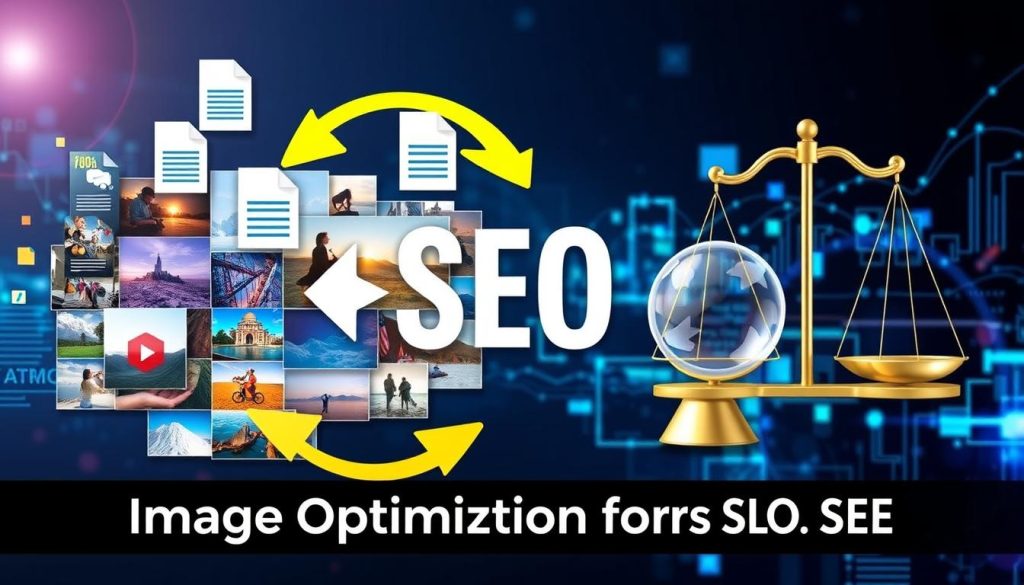
The Impact of Visual Content on Search Rankings
Visual content significantly influences search rankings. Search engines now use advanced algorithms to assess images, considering relevance, quality, and context. Websites that optimise their visual content well are more likely to rank higher, attracting more organic traffic.
Core Web Vitals and Image Performance
Core Web Vitals, Google’s user experience metric, heavily depends on image performance. Loading speed, visual stability, and interactivity are all influenced by image optimisation. By focusing on image SEO, you can boost your Core Web Vitals scores and improve search engine rankings.
| Core Web Vital | Image SEO Impact |
|---|---|
| Largest Contentful Paint (LCP) | Optimised images load faster, improving LCP scores |
| Cumulative Layout Shift (CLS) | Proper image sizing prevents layout shifts |
| First Input Delay (FID) | Efficient image loading improves overall page interactivity |
Mastering image SEO techniques is the first step towards successful visual search optimisation and enhanced website performance.
Image Optimisation Techniques for Enhanced SEO Performance
Mastering image optimisation techniques is vital for boosting your SEO performance. By implementing these strategies, you can significantly improve your website’s visibility and user experience. Let’s explore some key approaches to optimise your images for search engines.

Firstly, selecting the right file format is essential. JPEG works well for photographs, while PNG is ideal for graphics with transparency. WebP, a modern format, offers superior compression and quality, making it an excellent choice for web images.
Compression plays a vital role in image optimisation. By reducing file sizes without compromising quality, you can significantly improve page load times. This balance between size and quality is critical for SEO performance.
- Use descriptive file names
- Implement alt text for accessibility and SEO
- Optimise image dimensions for various devices
- Leverage browser caching for faster loading
Responsive images are another key aspect of image optimisation. By adapting images to different screen sizes, you ensure a seamless user experience across devices. This is increasingly important for search rankings.
Lastly, don’t overlook the power of image sitemaps. They help search engines discover and index your images more effectively. This can potentially boost your visual search presence.
By applying these image optimisation techniques, you’ll be well on your way to improving your website’s SEO performance. You’ll also provide a better experience for your visitors.
Choosing the Right Image Format for Web Usage
Choosing the right image format is key to improving your website’s performance and visual appeal. We’ll look at the most common formats and their best uses.
JPEG vs PNG vs WebP: Making the Right Choice
JPEG, PNG, and WebP are top image formats, each with its own strengths. JPEG is great for compressing photos, keeping file sizes small. PNG is perfect for logos and graphics, thanks to its quality and support for transparency. WebP, a newer format, offers better compression and quality, often beating JPEG and PNG.
| Format | Best For | Compression | Transparency |
|---|---|---|---|
| JPEG | Photographs | Lossy | No |
| PNG | Graphics, Logos | Lossless | Yes |
| WebP | All-purpose | Lossy/Lossless | Yes |
Understanding Vector vs Raster Images
Raster images, like JPEG and PNG, are made of pixels and can lose quality when enlarged. Vector images, such as SVG, use mathematical formulas to stay sharp at any size. They’re ideal for logos and icons.
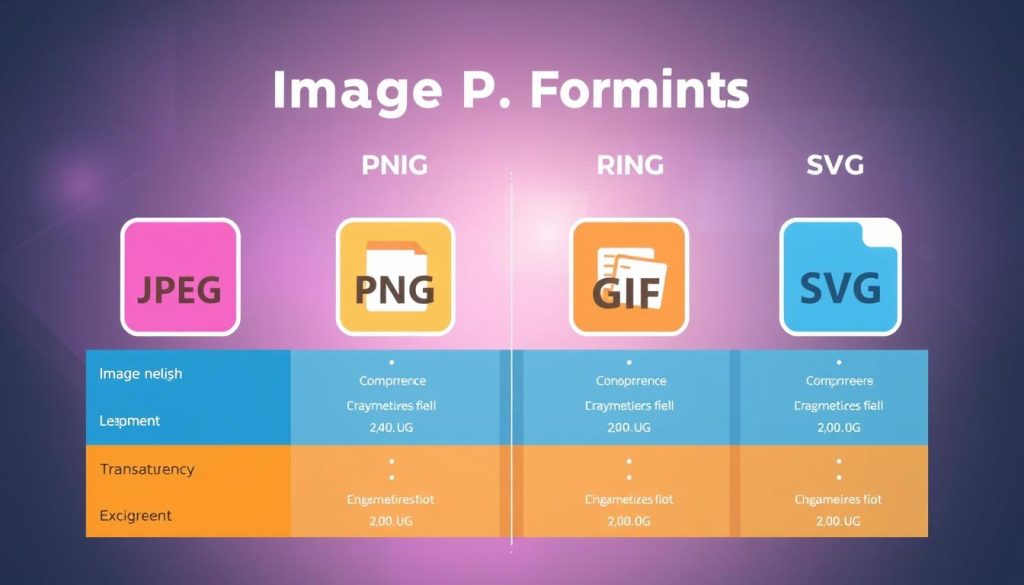
Modern Image Formats and Browser Compatibility
WebP is great for its compression and quality but isn’t supported everywhere. Use fallbacks or the picture element to ensure it works on all browsers. Always test your chosen formats on different devices to ensure they display well and load quickly.
Image Compression Strategies That Maintain Quality
Optimising your website’s performance requires finding the perfect balance between image compression and quality. Employing smart compression techniques can significantly reduce file sizes without compromising visual appeal.
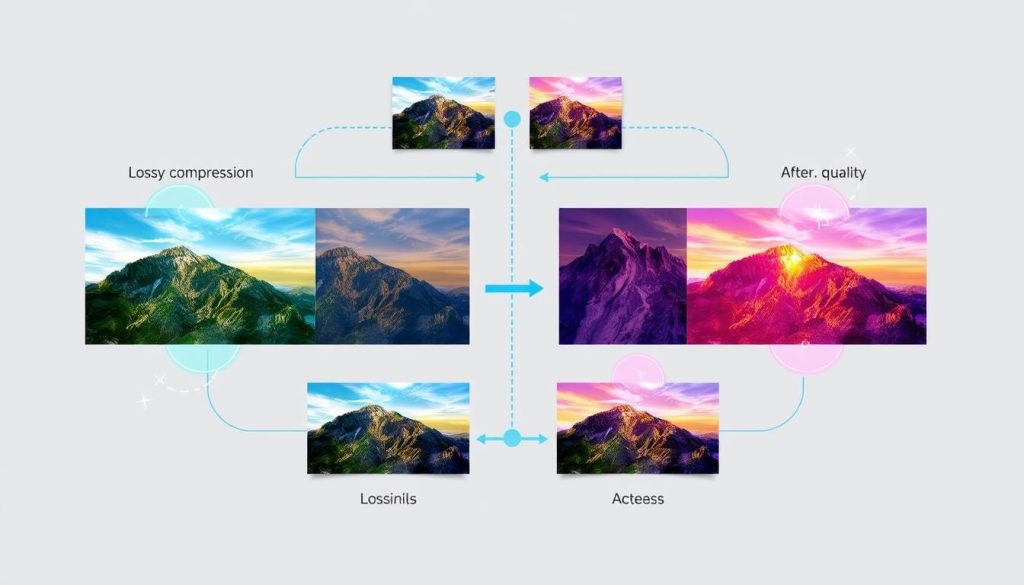
Lossless compression is a great starting point. It reduces file size by removing unnecessary metadata while keeping image quality intact. This method works well for graphics with large solid colour areas.
For photographs and complex images, lossy compression offers impressive results. It selectively removes data to drastically shrink file sizes. The challenge lies in finding the optimal compression level where quality is maintained.
Remember, the goal is to optimise images for web use, not print. A slight reduction in quality is often imperceptible online but can lead to substantial performance gains.
Modern image formats like WebP are worth considering. They offer superior compression compared to traditional JPEGs and PNGs. Many browsers now support these formats, allowing for smaller file sizes and faster load times.
| Compression Method | File Size Reduction | Quality Impact | Best For |
|---|---|---|---|
| Lossless | 20-30% | None | Graphics, logos |
| Lossy | 50-90% | Minimal to moderate | Photographs |
| WebP | 25-35% smaller than JPEG | Similar to JPEG | All web images |
By adopting these image compression strategies, you can improve your website’s loading speed and user experience. This is achieved while maintaining high-quality visuals.
Implementing Effective Image Alt Text Practices
Alt text is vital for image optimisation, boosting both SEO and accessibility. It’s about crafting compelling alt text that enhances your website’s performance and user experience.
Writing Descriptive Alt Text That Converts
Creating descriptive alt text is an art that requires balance. It should vividly describe the image and include relevant keywords. For instance, instead of “dog”, opt for “Golden Retriever puppy playing in a park”.
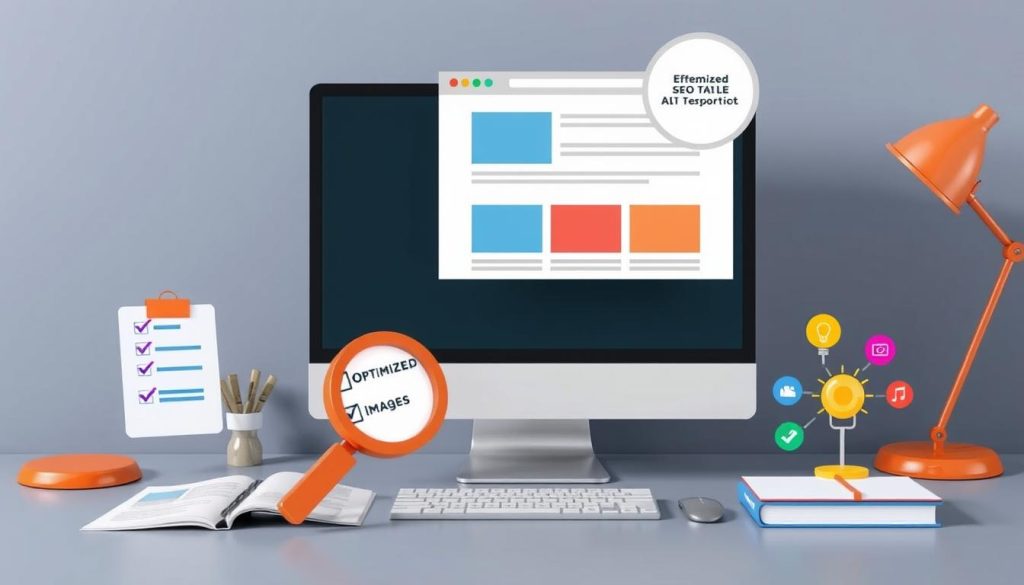
Alt Text SEO Best Practices
To enhance SEO, keep alt text concise (under 125 characters) and use natural language. Include target keywords where fitting. Alt text benefits both search engines and users, so aim for a balance between optimisation and readability.
| Do | Don’t |
|---|---|
| Use descriptive language | Keyword stuff |
| Include relevant context | Repeat information in captions |
| Keep it concise | Use generic phrases like “image of” |
Avoiding Common Alt Text Mistakes
Avoid common errors like empty alt text, overly technical language, or repetitive descriptions. Each alt text should be unique, adding value for both users and search engines.
“Effective alt text is like a window to your visual content, providing equal access to all users while boosting your SEO efforts.”
By adopting these alt text practices, you’ll enhance your website’s accessibility and search engine rankings. This creates a more inclusive and discoverable online presence.
Optimising Image File Names for Search Engines
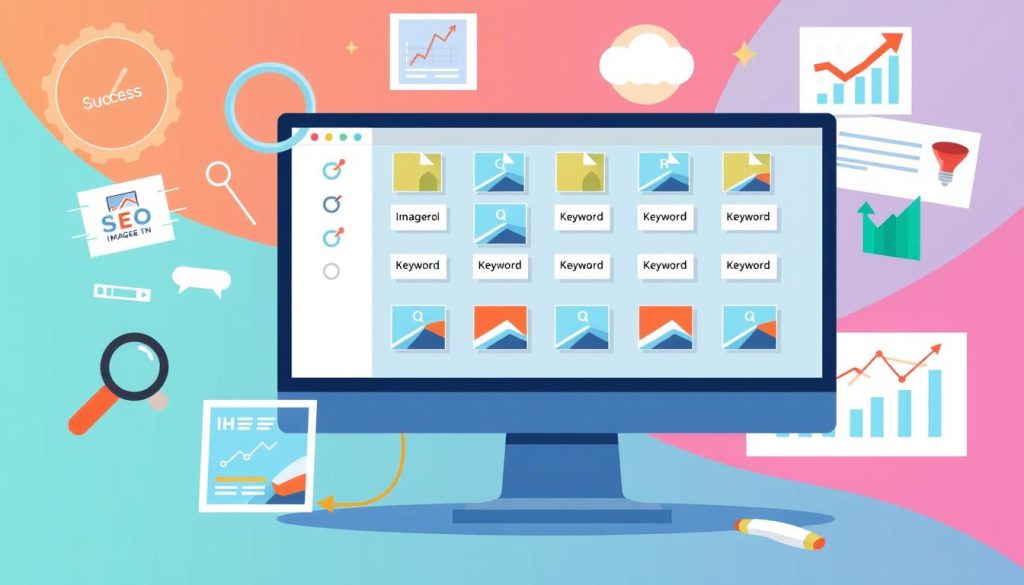
Proper image file names are vital for boosting your website’s SEO. Search engines use these names to grasp what your images show. By choosing descriptive, keyword-rich file names, you enhance your image search rankings.
Here are the best practices for naming your image files:
- Use relevant keywords that describe the image content
- Keep file names short and concise
- Separate words with hyphens, not dashes
- Avoid special characters and spaces
- Use lowercase letters throughout
Now, let’s examine some examples of good and bad image file names:
| Bad File Name | Good File Name |
|---|---|
| IMG_1234.jpg | red-sports-car.jpg |
| photo1.png | chocolate-chip-cookies.png |
| DSC00001.jpg | eiffel-tower-night.jpg |
By adhering to these naming conventions, you aid search engines in understanding your images. This can significantly boost your image search visibility and drive more traffic to your site.
“A picture is worth a thousand words, but a well-named image file is worth a thousand clicks.”
Optimising image file names is just one part of image SEO. Pair this with alt text optimisation and image compression for the best outcomes.
Responsive Images: Adapting to Different Screen Sizes
In today’s digital world, responsive images are key for a seamless user experience on all devices. By using mobile optimisation, images will look perfect on any screen, from smartphones to desktops.

Using Srcset and Sizes Attributes
The srcset and sizes attributes enable browsers to select the best image for each device’s screen size and resolution. This method greatly enhances page loading speed and cuts down data usage for mobile users.
Mobile-First Image Optimisation
Embracing a mobile-first approach means focusing on optimising images for smaller screens first. This involves creating lightweight images that load swiftly on mobiles while keeping visual quality high.
Picture Element Implementation
The picture element gives developers more control over how images are displayed on different screens. It allows for specifying multiple image sources and defining when each should be used, ensuring the best visual experience for all users.
| Technique | Benefits | Implementation Complexity |
|---|---|---|
| Srcset and Sizes | Improved performance, bandwidth savings | Moderate |
| Mobile-First Optimisation | Faster load times on mobile devices | Low to Moderate |
| Picture Element | Fine-grained control over image display | High |
By using these responsive image techniques, website owners can greatly improve their mobile optimisation. This leads to better user engagement and higher search engine rankings.
Leveraging Image Sitemaps for Better Indexing
Image sitemaps are vital for boosting your website’s search engine visibility. They offer detailed insights into your visual content. This helps search engine crawlers find and index your images more efficiently.
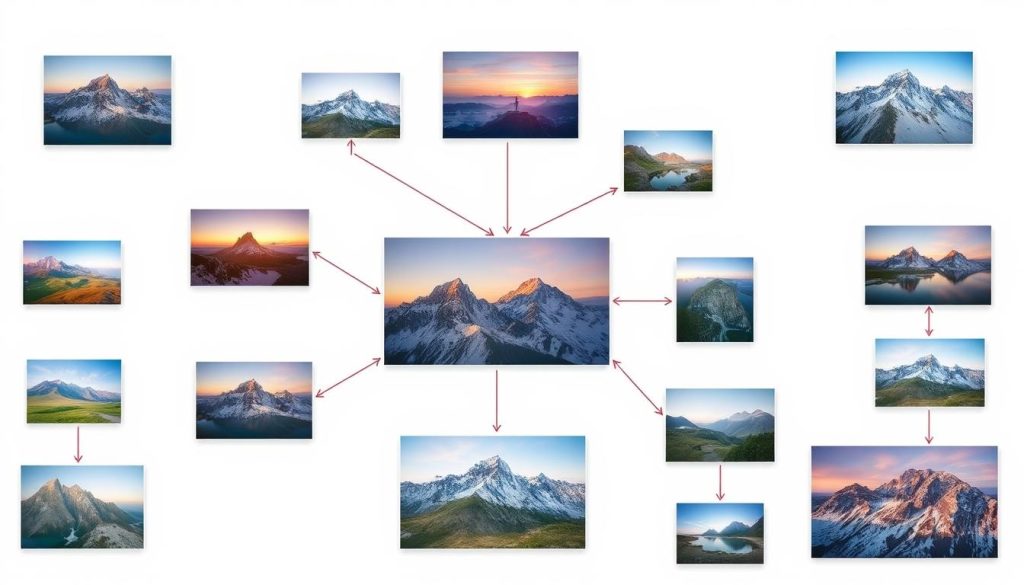
Creating an image sitemap is simple. Begin by listing all your image URLs, along with details like title, caption, and licence. This structured approach helps search engines grasp the context and importance of each image.
To implement an image sitemap:
- Generate a separate XML file for your images
- Include essential attributes like image:loc, image:title, and image:caption
- Submit the sitemap to search engines through their webmaster tools
- Regularly update your image sitemap as you add new visual content
Using image sitemaps gives search engines a clear path to index your visual content. This can significantly improve your visibility in image search results. It may also increase website traffic.
While image sitemaps aid in indexing, they’re most effective when combined with other optimisation techniques. Make sure your images have descriptive file names, alt text, and are compressed for better performance.
Image Loading Techniques for Faster Page Speed
Optimising image loading is key to better website performance. Smart loading techniques can greatly improve your site’s speed and user experience.
Lazy Loading Implementation
Lazy loading delays the loading of images off-screen until they’re viewed. This method cuts down initial page load times and bandwidth usage. To use lazy loading, add the ‘loading=”lazy”‘ attribute to your img tags or employ JavaScript libraries for this task.
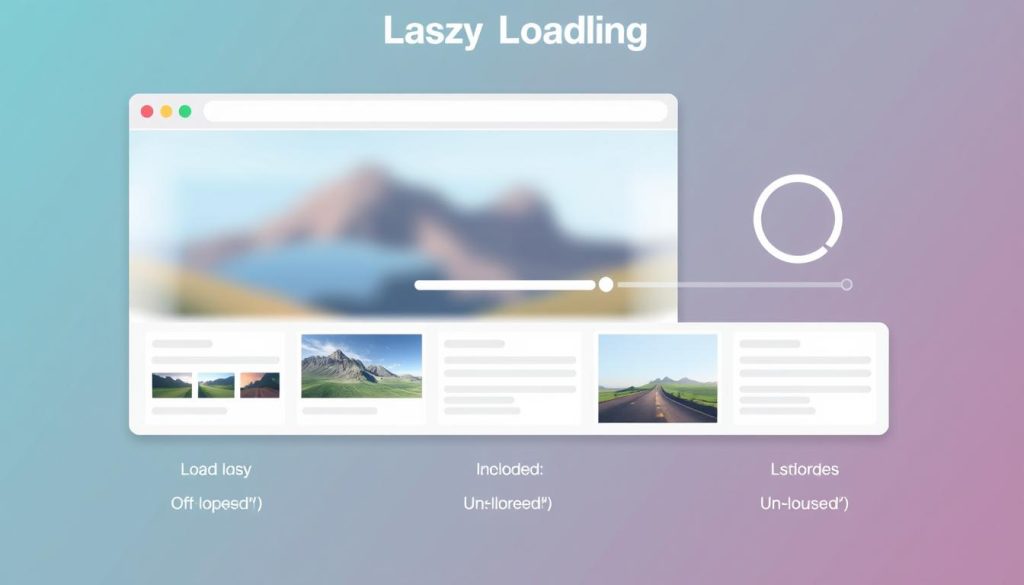
Progressive Image Loading
Progressive loading shows a low-resolution image first, then improves it as it loads fully. This technique gives users quick visual feedback, making pages seem to load faster. Use progressive JPEG format or JavaScript to load image placeholders initially.
Browser Caching for Images
Browser caching stores images locally on a user’s device. This means no need to re-download images on future visits, speeding up load times for returning users. Ensure your server sets the right cache-control headers for effective browser caching of images.
| Technique | Benefits | Implementation Complexity |
|---|---|---|
| Lazy Loading | Reduces initial load time, saves bandwidth | Low to Medium |
| Progressive Loading | Improves perceived load time, enhances user experience | Medium |
| Browser Caching | Faster load times for returning visitors, reduced server load | Low |
By integrating these methods, you can develop a strong image loading strategy. This will significantly enhance your website’s performance and user satisfaction.
Optimising Images for E-commerce Success
E-commerce image optimisation is key to driving sales and improving user experience. High-quality product images are vital for displaying your merchandise effectively. They help convince customers to buy.
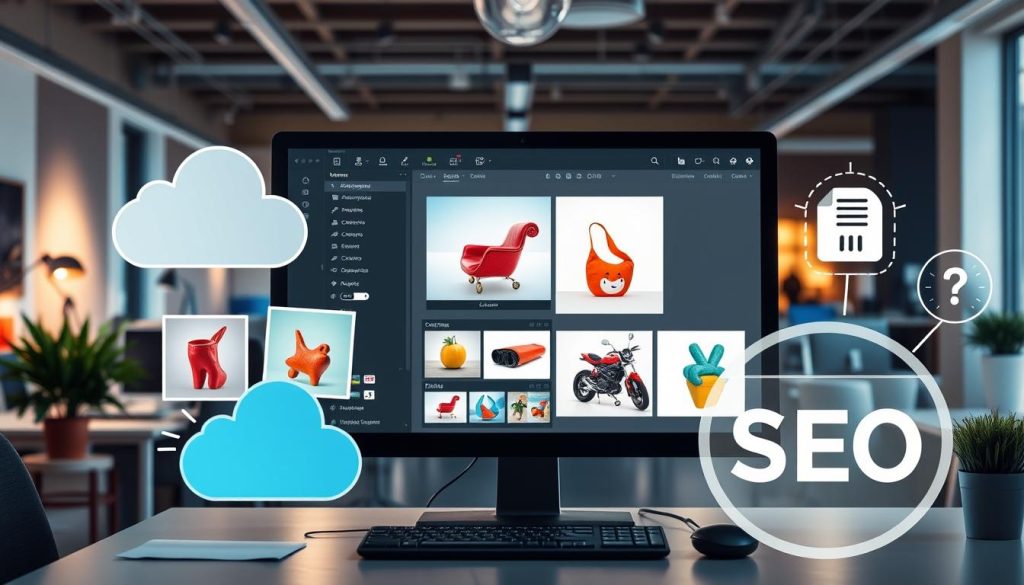
To enhance your online store’s performance, consider these strategies:
- Use multiple angles: Offer various views of your products to give customers a full understanding of what they’re buying.
- Enable zoom functionality: Let users examine product details closely, mimicking the in-store experience.
- Maintain consistency: Ensure your product images have a uniform style to create a cohesive brand identity.
- Optimise for visual search: Use proper alt text and descriptive file names to improve discoverability through image search engines.
Optimised product images not only enhance your site’s aesthetics but also contribute to faster loading times. They also improve search engine rankings. By implementing these e-commerce image optimisation techniques, you’ll create a more engaging shopping experience. This drives conversions and boosts your bottom line.
“A picture is worth a thousand words, but in e-commerce, it’s worth a thousand sales.”
Invest time in perfecting your product images, and you’ll see increased customer engagement and higher sales. E-commerce success relies heavily on visual appeal. So, make sure your images stand out.
Using Content Delivery Networks (CDN) for Image Distribution
Content delivery networks are key to optimising image distribution online. They enhance your site’s performance by serving images from nearby servers. This approach can make a significant difference in how fast your website loads.

Benefits of Using LerriHost’s CDN Services
LerriHost provides advanced CDN services for image distribution. Their network ensures images load quickly, reducing bandwidth costs and improving user experience. With LerriHost’s CDN, websites can enjoy:
- Faster image loading speeds
- Reduced server load
- Improved website reliability
- Enhanced SEO performance
Global Image Delivery Optimisation
Optimising global image delivery is vital for international websites. LerriHost’s CDN uses cutting-edge methods to deliver images swiftly worldwide:
| Technique | Benefit |
|---|---|
| Edge Caching | Stores images closer to users |
| Intelligent Routing | Selects fastest server path |
| Automatic Compression | Reduces file sizes on-the-fly |
| Dynamic Resizing | Adapts images to device screens |
Through these strategies, LerriHost’s CDN ensures images are delivered efficiently to users globally. This boosts your site’s performance and user satisfaction.
Image Copyright and Licensing Considerations
Using images on your website requires a grasp of image copyright and licensing. Proper management of these aspects safeguards you legally and maintains ethical standards in digital content creation.
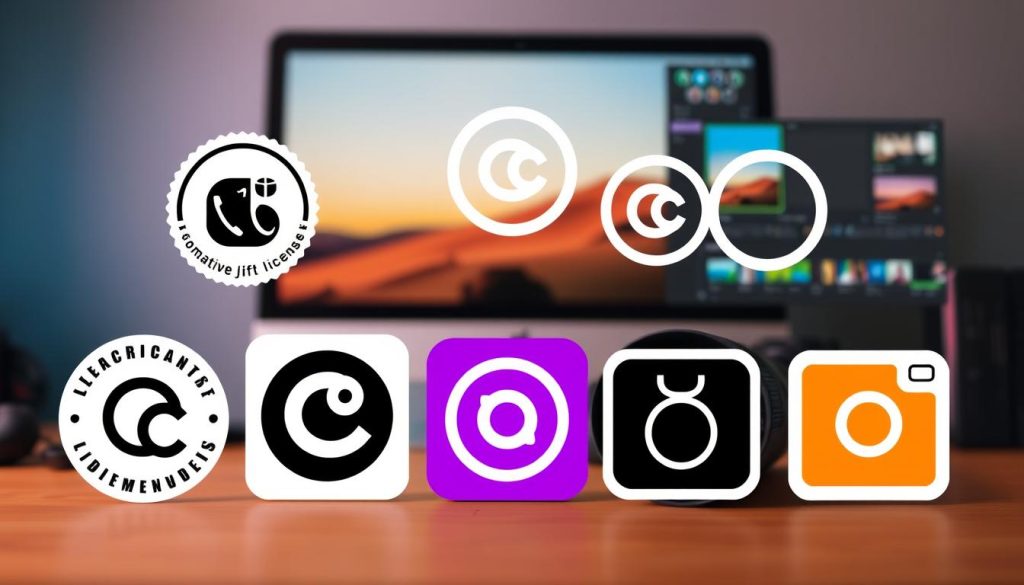
Image licensing varies widely. Creative Commons licenses permit free use under certain conditions, whereas commercial licenses often demand payment. It’s vital to meticulously read and adhere to each license’s terms.
To sidestep copyright disputes, consider these strategies:
- Utilise reputable stock photo websites
- Produce your own images
- Obtain permission for copyrighted images
- Document image sources and licenses
Attribution is frequently necessary for licensed images. This entails crediting the creator and linking to the license. Neglecting this can result in legal repercussions.
“Respecting image copyright is not just a legal obligation, it’s a way to support and acknowledge creative work.”
Compliance with image copyright laws and licensing stipulations showcases your professionalism and respect for intellectual property. This stance builds trust with your audience and safeguards your website from legal challenges.
Tools and Resources for Image Optimisation
Image optimisation tools are vital for boosting website performance and SEO. They range from free options to premium solutions, catering to different needs and skill levels.
Free vs Premium Image Optimization Tools
Free tools offer basic functionality, perfect for small projects. Premium tools, on the other hand, have advanced features, ideal for businesses with large image processing needs.
| Feature | Free Tools | Premium Tools |
|---|---|---|
| Batch Processing | Limited | Extensive |
| Compression Quality | Good | Excellent |
| Format Conversion | Basic | Advanced |
| API Access | Rarely | Often Included |
LerriHost’s Image Optimization Solutions
LerriHost provides powerful image optimisation tools for businesses. Their solutions fit seamlessly into existing workflows, ensuring top image performance without sacrificing quality.
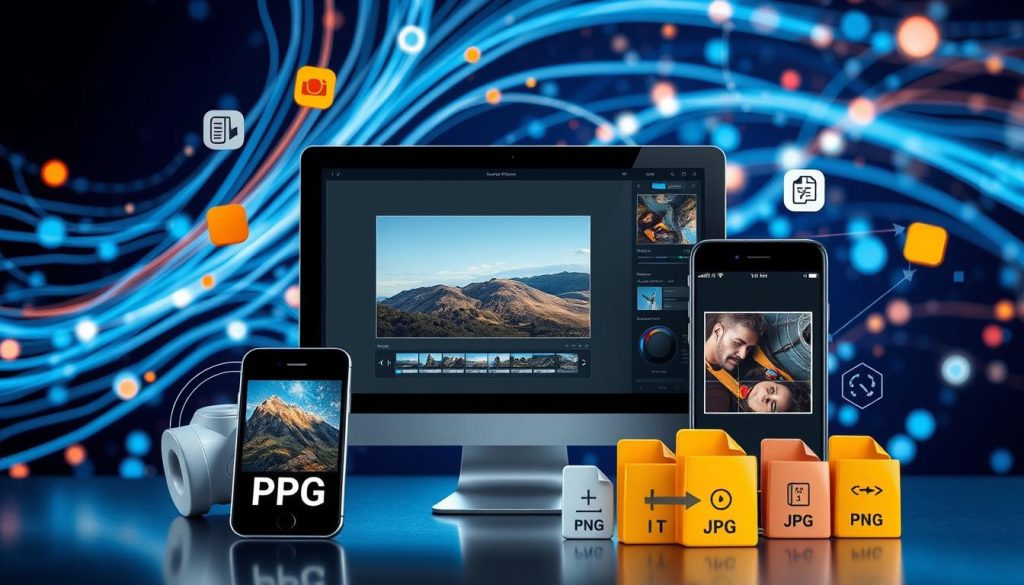
Automated Image Optimization Workflows
Automation in image optimisation makes the process quicker and more consistent. These workflows handle tasks like resizing, compressing, and format conversion automatically. This reduces manual effort and minimises errors.
- Bulk image processing
- Automatic format selection
- Intelligent compression
- Metadata retention
By using these tools and resources, websites can greatly enhance their visual content’s performance and SEO. Whether choosing free solutions or investing in premium tools, the key is consistent application of image optimisation practices.
Conclusion
Image optimisation techniques are essential for boosting your website’s SEO performance. By implementing the strategies we’ve discussed, you can significantly improve your site’s search engine rankings and user experience. From choosing the right file formats to crafting descriptive alt text, each step plays a vital role in boosting your visual content’s impact.
Optimising images isn’t just about reducing file sizes. It’s about finding a balance between quality and performance. Using responsive images, lazy loading, and CDNs are powerful tools in your SEO toolkit. These methods ensure your visuals look great and load quickly across all devices, keeping visitors engaged and search engines happy.
Don’t overlook the importance of image sitemaps and proper licensing. These often-forgotten aspects can make a big difference in how search engines perceive and index your visual content. By addressing all these elements, you’re setting your website up for success in the increasingly visual online landscape.
Start applying these image optimisation techniques today. You’ll soon see improvements in your SEO performance, faster load times, and happier visitors. It’s a win-win situation that will keep your website competitive in today’s digital world.
